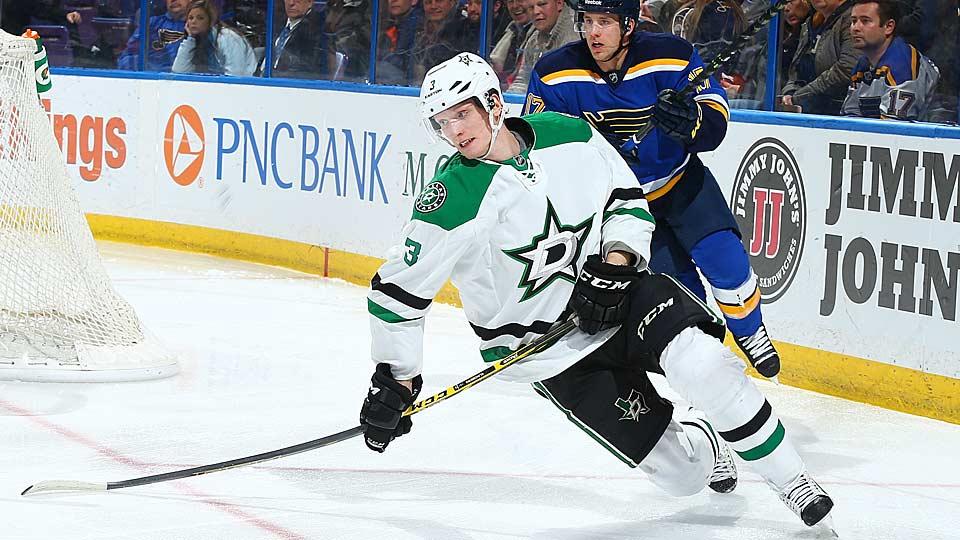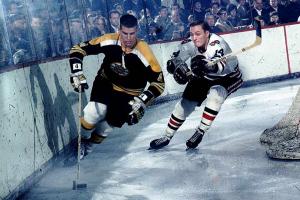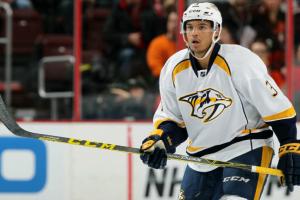
When Stars defenseman John Klingberg was learning to play hockey as a boy in Sweden, one thing stood out. He was always the smallest kid on the ice. Rather than give up on his dream of playing professionally before it even started to take root, Klingberg had to adapt.
“I had to be smart,” he told SI.com by phone from his native country.
That meant learning to not get crushed in the corners by hard-charging forwards, to get out of a scrum with the puck and to play within his team’s structure and not for himself.
Developing a shrewd hockey sense has made Klingberg one of the game’s rising stars. The still small 22-year-old does not look like the prototypical defenseman. He doesn’t lay out crushing hits like classic back line bruisers such as Scott Stevens, doesn’t dole out nasty punishment with elbows and sticks the way ChrisPronger used to and doesn’t blast pucks through the net like Shea Weber does.
Yet Klingberg has plenty going for him, especially after scoring 40 points in 65 games as a rookie last season. At 180 pounds, he is not an anomaly in the sport.Erik Karlsson, the league’s top-scoring defenseman of 2014–15 and a two-time Norris Trophy winner, weighs 180. Duncan Keith, the reigning Conn SmytheTrophy-winner and a three-time Stanley Cup champion, tips the scales at 192. Of the top 10 scoring defensemen in the NHL last season, seven weighed less than 205 pounds. As the league moves to a wide-open, high-scoring game, coaches are putting a greater emphasis on smaller, mobile defensemen who can skate the puck out of their own end and make plays in the offensive zone.
For Dallas, investing seven years and nearly $30 million in a defenseman who has only 65 games under his belt is not guesswork. It’s the new NHL.
Offensive defensemen are hardly a new development. During the 1950s, Canadiens Hall of Famer Doug Harvey put a stranglehold on the Norris with dynamic skills that enabled him to spearhead a swift transition game. He turbocharged Montreal’s fire-wagon offense with his skating and passing while playing the role of shutdown defender. Harvey also quarterbacked a power play that was so lethal the NHL had to the change the rules limiting the number of times a team could score after a minor penalty before the a player in the penalty box was allowed to return to the ice. The Bruins’ Bobby Orr took the offensive dimension of a blueliner to a whole new level in the 1970s when he scored 124 points in 1970–71 to win the scoring title.“He’s the one that changed the game,” says Danny Flynn, the head coach of theQMJHL’s Saint John Sea Dogs, and a former assistant with the Sabres. “He made the defenseman a part of the attack, he made the defenseman part of the rush. [He] really was a pioneer.”
Orr paved the way for high-scorers like Denis Potvin, Paul Coffey, Ray Bourqueand Phil Housley, among others. But by and large, defensemen of that era were still asked to play a defensive style first.
A typical forecheck played out like this: An opposing winger would dump the puck in. A defenseman would go back to retrieve it while a winger attempted to hold up the forechecker and his defense partner screened and watched out for him. After the lockout of 2004–05, the NHL instituted rule changes designed to improve offense. In came the two-line pass; out went clutching and grabbing, and the old style of defending dump-ins. The new rules opened up the ice, leaving more room for skilled players to show off their talents. At the same time, the changes made it harder for slower defensemen to keep up.
“The rule changes have been good to speed up the game,” says Rick Bowness, an assistant coach for the Lightning. “It’s a much faster game. It’s a beautiful game to watch.”
Suddenly, the 6′ 7″, 250-pound bruiser whose sole job was to pound opposing forwards into submission in front of the net was not as valuable as a guy who could skate fast and make plays. Defensemen have to get the puck in the corner and get it out—quick.
The speed of the game has allowed smaller, faster players on both sides of the ice to flourish. Blackhawkswinger Patrick Kane—all of 5′ 11″ and 181 pounds—has become of one the best players in the league. Tampa Bay center Tyler Johnson—5′ 9″, 175— just scored 29 goals during the regular season and had 23 points in the playoffs. As blazing skaters, both Kane and Johnson have taken advantage of the increased room on the ice to make dazzling plays.“Go look at Johnny Gaudreau,” an Eastern Conference scout told SI.com, referring to the Flames’ 5′ 9″, 150-pound water-bug winger, who had 64 points as a rookie and finished third in the Calder Trophy voting. “We’re in the business of entertaining.”
But getting the puck to these skilled entertainers begins in the defensive zone.John-Michael Liles, a 5′ 10″, 185-pound defenseman for the Hurricanes, has gone into the corner to retrieve pucks countless times during his 11-year career. He says he’s aware of the often bigger forwards bearing down to crush him. ButLiles does have one advantage.
“As a smaller defenseman, I’m just trying to use my quickness and speed to get some sort of body position,” he says. “There are times you get hit. [But] if you are undersized and can skate and make a good first pass, I think you can still play the game.”
Once someone like Liles is able to use his speed to outskate a forward to get the puck, the next critical thing is to get the biscuit up the ice. The NHL has become a puck possession game; the longer a team has the puck, the more offensive chances it will create and the more successful it will likely be. Puck possession starts with the defensemen.
“Today’s game is all about getting the puck out of your zone as quick as you can,” says Jim Nill, the general manager of the Stars. “The quicker you can make a pass out of your zone, the less time you’re going to spend defending.”
The epitome of this model is Chicago, which is coming off its third Cup championship in the last five years. Led by Keith, the Blackhawks excel at getting the puck and moving it out quickly. In this year’s Cup final against the Lightning, coach Joel Quenneville relied on his team’s ability to move the puck and open up space for its forwards.
“We found over the course of the series, you want to get it out as crisply as possible,” Quenneville says by phone. “We found that when we just got it out [of the zone], it really loosened up some of the pressure we got [from Tampa Bay].”
The NHL game is different than it used to be in the 1990s. It’s faster, leaner. And the post-lockout changes have trickled down to the junior levels, grooming a long line of talented, fleet-footed defensemen. All eight backliners who were selected in the first round of this year’s NHL draft weighed 206 pounds or less. Teams are even looking at guys whose size would have previously made them persona non grata in the old clutch and grab league, in which goons patrolled the ice and a premium was placed on size. In the third round, the Red Wings drafted Vili Saarijarvi, a 5′ 10″, 163-pound Finnish defenseman who played last season in the USHL. Saarijarvi, through a translator, says that the Wings told him they like his ability to drive possession.“If you look at a Keith or a Karlsson, 20 years ago, [teams] would’ve looked at them, [and said], ‘They’re not real big, do we have a job for them?’ ” says St. John’s Flynn. “And now those guys are premier guys.”
Darrell Young, the GM of the Sea Dogs, saw what happened when elite skaters took the ice even if they weren’t the biggest guys around. Two of his defensemen, Jakub Zboril and Thomas Chabot, were both drafted in the first round this year—Zboril 13th by Boston, Chabot 18th by Ottawa. Zboril is 6-foot, 184 pounds. Chabot is 6′ 1″, 180. Both of their skill sets are tailor-made for the new NHL.
“You have to get guys who can handle the puck,” Young says. “In the old days, you had guys who could play strong physical defense, protect their own end, but in the other two zones they weren’t very effective.”
Both Zboril and Chabot are three-zone players. Zboril, according to Young, has a lot of skill and “plays like he wants to hurt people.” Chabot, per Young, was the most elite skater among the defenseman in the CHL prospects game last January, a contest in which No. 7 draft pick Ivan Provorov also played.
“You can’t play in the NHL unless you can skate,” says Dan Marr, the director of NHL Central Scouting. “If you can’t get the puck out of your own end, you’re in trouble. You just can’t afford to have a player who can’t move out there.”
Even for smaller defenseman, the fear of not being able to keep up remains.Jared Spurgeon is a 5′ 9″, 185-pound backliner with the Wild. His off-seasons, he says, are always focused on improving his skating.
“Skating is always a huge thing in the summer,” Spurgeon told SI.com. “Our division is very skilled. That speed is huge for me, especially being a smaller guy.”
The league is never going to fully transition to an all-small lineup. There is still a need for bigger defenseman. Take the dichotomy between the Bruins’ Torey Krug and Zdeno Chara. Krug stands 5′ 9″ and tips the scales at 181 pounds. Chara weighs in at 6′ 9″, 255. Both sizes have their advantages and disadvantages.
“He can get away with more things than I can,” Krug says of Chara. “If his gap isn’t perfect, he overcomes that with the ability to use his stick, which is taller than me.”
Krug points out, however, that his size gives him certain advantages, especially when defending the rush. Many teams are entering the zone now with numbers and with speed, as opposed to simply dumping the puck in. Krug says that his skating ability helps him tremendously when dealing with elite playmakers such as Kane. “You have to be able to set your gap,” he says. “Those guys, they’re changing their speeds as well. You have to adapt to it. Using your skating ability is crucial.”When a skilled defenseman can combine elite speed with offensive prowess, something special is afoot, regardless of his size. That’s what happening with Klingberg who, while scoring his first NHL goal, deked Coyotes forward Mikkel Boedker with a toe drag, then wristed a shot top-shelf past goalie Mike Smith.
“We think he’s going to be a top-two defenseman in the NHL,” says Nill. “To do what he did, over 60 games, is pretty impressive.”
Klingberg’s play draws natural comparisons to Karlsson. They are both from Sweden, both of similar stature and both play a similar game. Klingberg may be on the path towards joining Karlsson in the elite stratosphere of defensemen, but he insists that he’s setting his sights on just being himself.
“You don’t want to try to be like him,” Klingberg said. “But he’s a success, so I can try to do some of that stuff. But I try to play my own game.”
And that game, of course, is the NHL’s latest version.




